Magento 2 Delivery Date Extensions

It is always a good idea to inform your customers about all possible nuances related to orders they make. Delivery date is one of the most critical aspects that must be displayed on the frontend. Unfortunately, you cannot do that in a natural and customer-friendly manner in case of the default platform, but the desired functionality may be added with the help of Magento 2 delivery date extensions. Below, you will find the most reliable modules that provide corresponding features.

Table of contents
Magento 2 Delivery Date Extension by Amasty
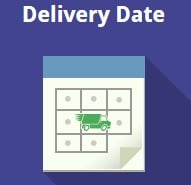
With the help of the Magento 2 delivery date extension by Amasty, you will efficiently provide clients with an advanced delivery schedule. The module radically improves the default shopping experience providing buyers with an opportunity to choose the most convenient time for the delivery. At the same time, you can easily disable specified days from the delivery schedule. For instance, you don’t want to work on holidays and weekends – these days can be defined as unavailable for the delivery.
The core feature of the Magento 2 delivery date module by amasty is a new interface that allows customers to specify the date and time of the delivery. To get additional information, you can enable delivery comments. You can control the display of new frontend elements, as well as exclude specific dates from the delivery plan. Furthermore, the Amasty’s extension lets you set min and max delivery intervals!
The provided delivery intervals are highly customizable. Both minimum and maximum delivery intervals are entirely suitable for all e-commerce requirements due to exceptional flexibility. You can even set time by which an order should be placed for the same day delivery, not to speak of hourly delivery slots.
The mentioned above minimal delivery intervals provide extra flexibility: you can set them on per product base. This feature helps to ensure faster delivery of specific products.
Customers also get some advanced functionality. While many Magento 2 delivery date extensions allow setting a delivery date before the order is placed, the Amasty’s solution provides the ability to change this parameter even after. Besides, the module sends notifications informing buyers about the upcoming delivery. From the customer perspective, the delivery date can be modified even after an order is placed.
Backend
Below, you can see a gif image that illustrates the configuration section with the mentioned above parameters.
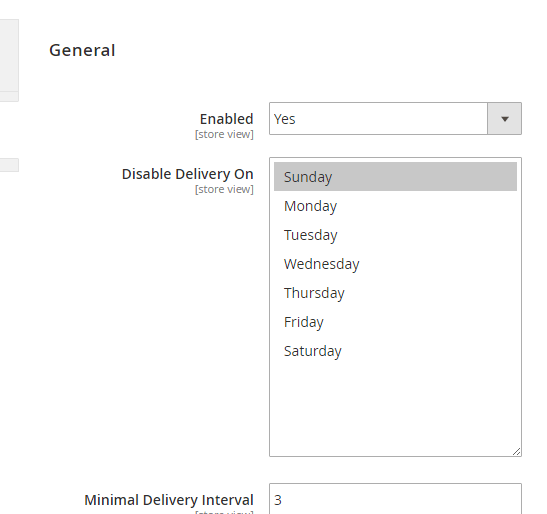
You can even set the number of deliveries per day or day of the week. Note that it can be unlimited as well. Besides, you can set a default value and a custom message, as well as set limitations on the delivery date feature display for shipping methods and customer groups.
The rescheduling feature that was mentioned above may be enabled/disabled as well. Besides, you can define rules which allow delivery date editing by customers. The Magento 2 delivery date extension by Amasty allows specifying an order status that enables rescheduling. Also, you can set a time interval for editing delivery date.
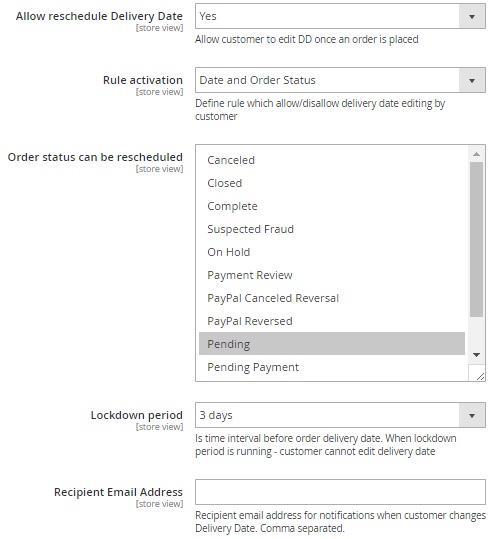
Moreover, you can freely enable/disable customer comments and reminders. The appropriate sections are available in the backend.
As for working days and holidays, the Magento 2 delivery date extension gathers them in a grid:
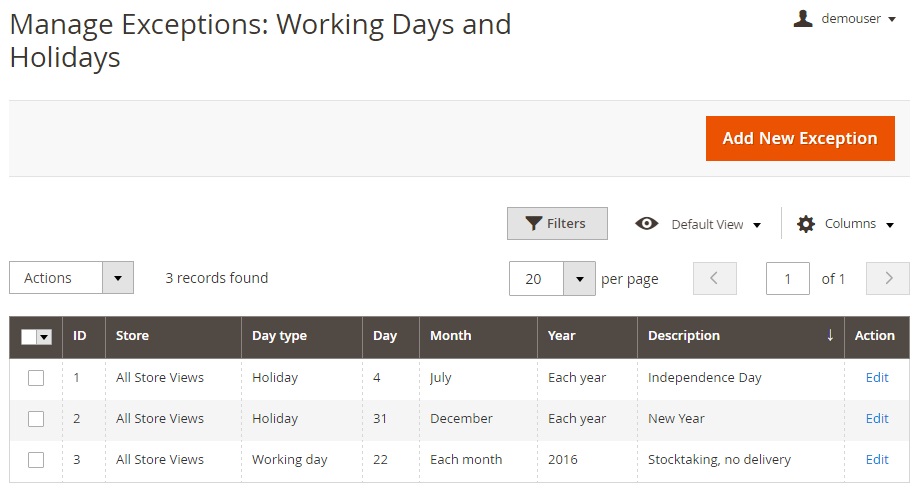
While adding a new exception, you should choose a store view, day type (it may be a holiday or a working day), and a specific day, month, and year. Don’t forget to add the description.
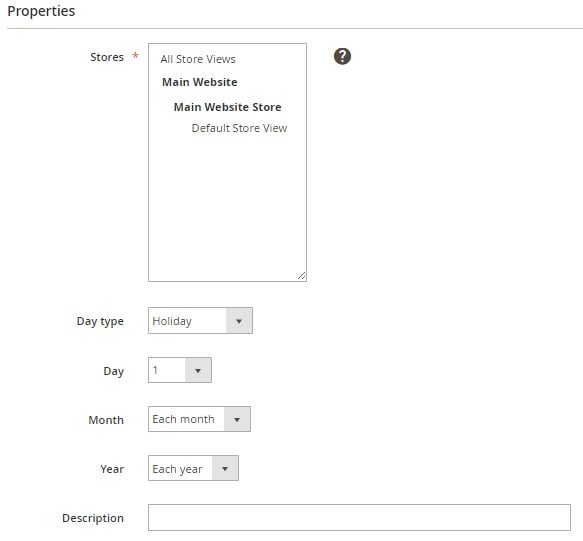
The Magento 2 delivery date module works the same in the situation with date intervals for the blocked delivery.
Frontend
The Amasty Delivery Date Magento 2 extension adds a new element to the standard checkout page. Customers can select a delivery date from the available range of dates, as well as leave delivery comments (if they are enabled). Everything looks as follows:
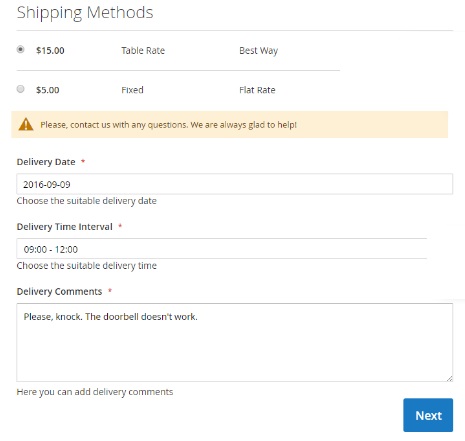
The delivery date specified on the checkout page may be changed in a customer account.
The price of the Amasty Magento 2 delivery date extension is $179. You can find more information here:
Magento 2 Delivery Date Extension by Wyomind
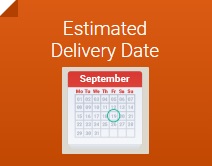
Another important Magento 2 delivery date extension is offered by Wyomind. The principle behind the module is absolutely the same as in case of the plugin above, but let’s describe its features in more details.
Estimated Delivery Date by Wyomind displays the corresponding information right on the frontend. It offers flexible backend interface, adds countdowns to the storefront, allows adding a customizable delivery date message, and supports current time and days off in calculation. Support for restocking date is provided as well.
As a Magento 2 administrator, you get the same authorities as provided by Amasty. The Magento 2 delivery date extension lets you change the display of the estimated delivery date message. At the same time, you can fully leverage variables, making your message more individualized and appealing to customers. Another competitive advantage is the ability to place a countdown on each product page.
Due to the store view support, the extension allows you to create individual delivery conditions for each store view – a must-have feature for international retailers. And you can freely leverage days off and current time in the delivery date calculation algorithm.
With the help of the advanced lead times management, you can enhance each product. Note that product attributes are supported, and it is possible to streamline the feature with configurable products and product custom options.
Another essential benefit of Wyomind’s Magento 2 delivery date extension over Amasty’s one is the restocking date functionality. Add the additional data to each product page improving the existing shopping experience.
Backend
The configuration section of the Magento 2 delivery date extension by Wyomind is vast, but it provides the module with additional flexibility. For instance, you can choose store opening days, specify store days off, and create a date format. Then, the extension allows specifying a custom delivery date message. You can use variables as we’ve just mentioned. Not the unlike Amasty, Wyomind displays the message in a shopping cart, transaction emails, and customer account by default. Additionally, you can add it to the top of the cart and checkout page. Below, you can see an image that shows the usage of variables in the delivery message.
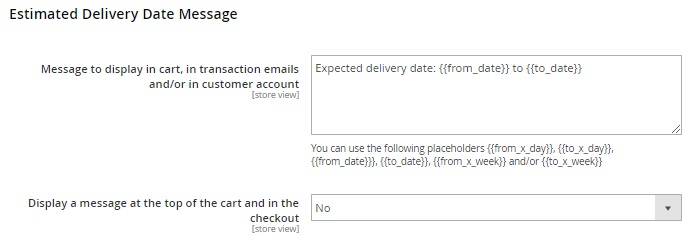
Note that you can create different settings for in-stock and out-of-stock products. Custom options may be used for making the delivery message and conditions more precise as well.
There is also a configuration section dedicated to a countdown. Select its format and enable/disable real-time display.
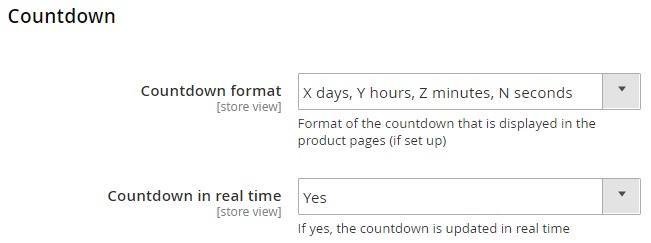
There is also a preview section that lets you eliminate all mistakes even before displaying anything on the frontend. This is how the preview looks:
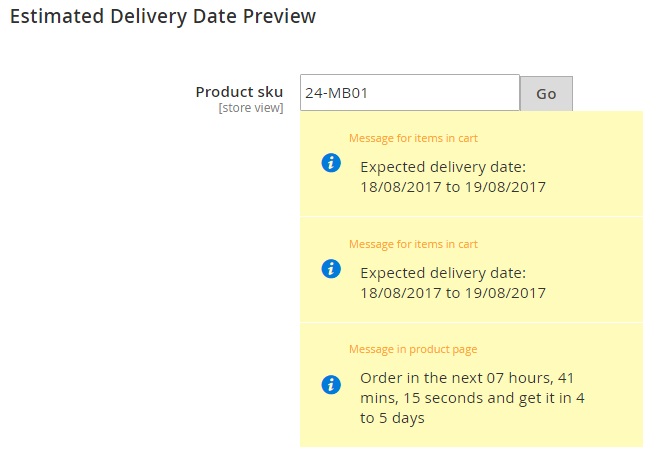
You can find more backend features in our review here: Magento 2 Delivery Date Extension by Wyomind. Now, let’s say a few words about the frontend appearance of the module.
Frontend
The countdown mentioned above looks as follows on a product page:

A customer can see how much time in advance he/she has to order the product and get it in the fastest possible way. If it is a configurable product, the countdown is displayed when an option is selected.
In a shopping cart, the delivery message has the following appearance:

Although Wyomind and Amasty offer modules with similar names, these are two different tools that can be used together: one to provide customers with the ability to select a delivery date, and another one to inform store visitors about possible delivery time.
The Magento 2 delivery date extension by Wyomind costs just €70. For further information, visit its official page here:
Magento 2 Delivery Date Extension by Plumrocket
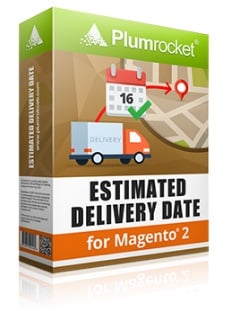
If you don’t know what plugin to use, we still have two more Magento 2 delivery date extensions. Plumrocket provides the first one. It adds the delivery message to product pages, shopping cart, and transactional emails. Besides, you can show it on category and checkout pages. As for documents, the plugin support order confirmation, invoice, and shipment emails. From the backend perspective, the appropriate information is added to order pages. You can set delivery dates globally (for the whole store), for each category level separately, and on per product basis.
It is also necessary to mention that the Magento 2 delivery date extension by Plumrocket allows specifying a delivery cut-off time – an interval after which same-day shipping won’t be available. Thus, the tool is similar to the Magento 2 delivery date module by Wyomind.
Backend
The configuration section is divided into three sub-sections. The General one allows selecting where to display the message on frontend pages, in emails, and on backend pages. The range of supported items is much wider than in case of the two previous modules:
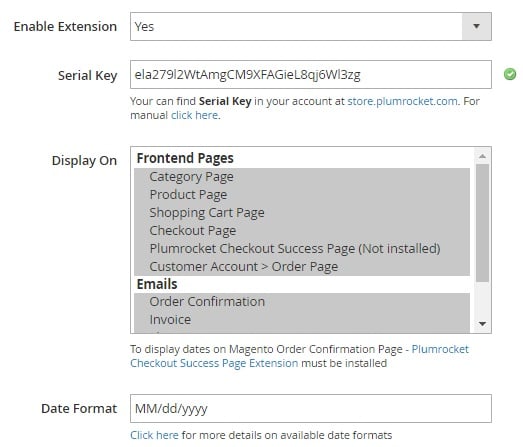
Next, create a delivery date text, specify the cut-off time, and create a list of holidays and weekends:
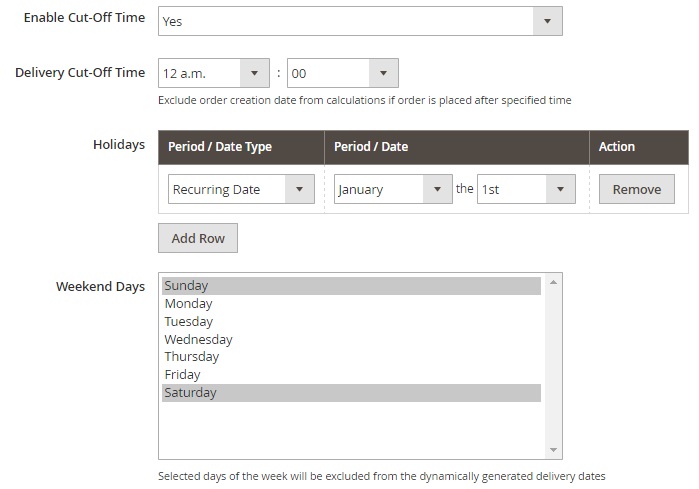
You can also configure the delivery date display via the backend section that contains all categories:
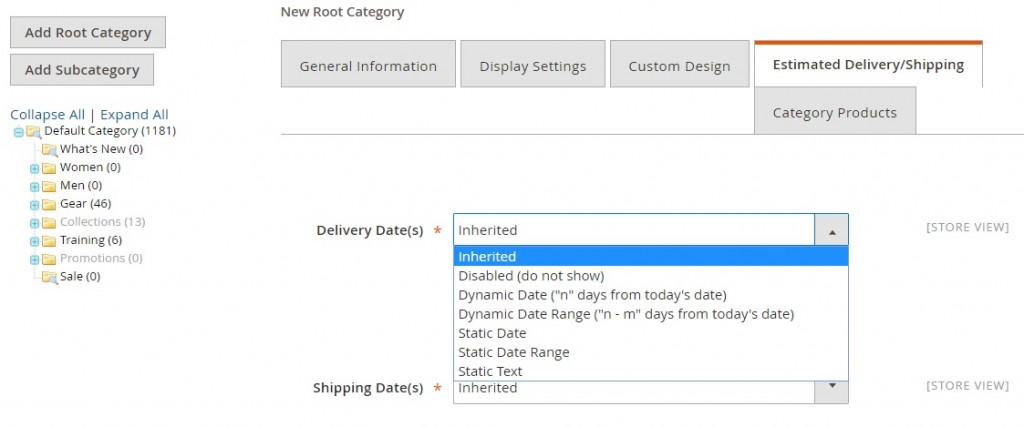
Below, you can see how to manage the new feature for individual products:
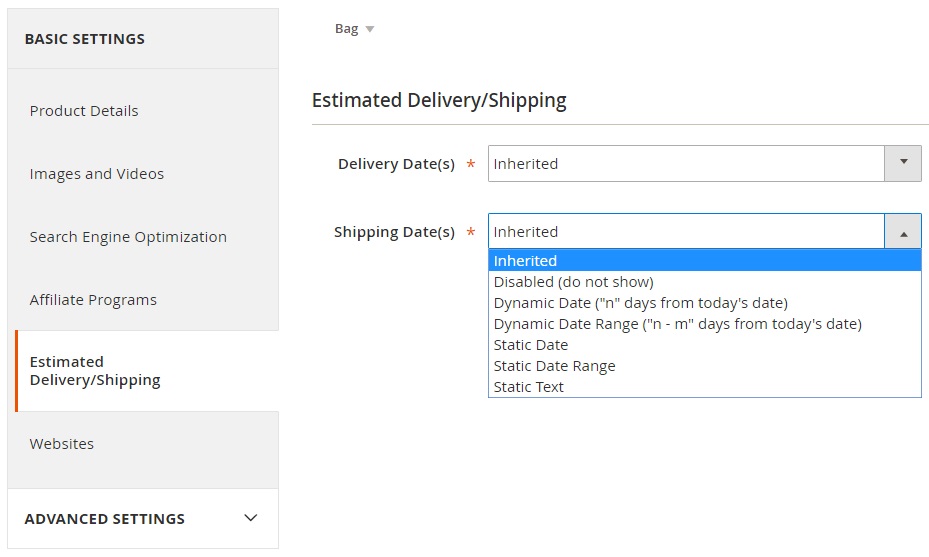
Frontend
Take a look at a category page and how the Magento 2 delivery date extension by Plumrocket affects it:

The same information on a product page:

The message in a shopping cart is similar to the ones above:
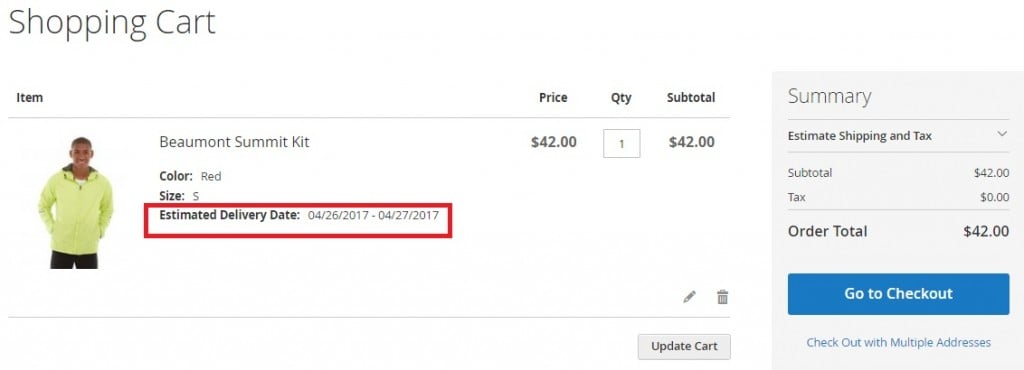
And this is a checkout page example:
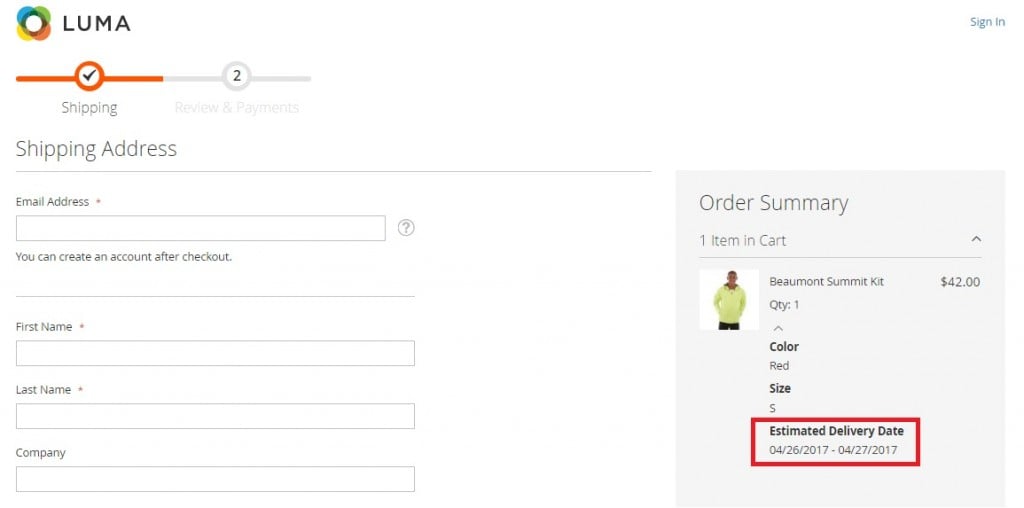
The Plumrocket’s solution offers a much wider selection of pages and documents where you can place the delivery date message. The module costs $119, and you can purchase it here:
Magento 2 Delivery Date Extension by MageDelight

Magedelight offers another tool that provides flexible delivery conditions. This Magento 2 delivery date extension is more similar to Amasty’s solution since it introduces the ability to select the exact delivery date and leave various comments. As a backend administrator, you can set some specific conditions that should be met to leverage the desired functionality.
With the help of the module, you can provide store visitors with time slots for product delivery, a handy comment box for additional delivery conditions, the ‘Call me before delivery’ feature, an opportunity to edit the selected delivery date after order placement, and special prices for certain delivery options. Looks like the Amasty’s extension on steroids.
To make the long story short, let’s proceed right to the backend section.
Backend
After enabling the delivery date functionality, specify a label for the delivery date options – you can create a custom name for delivery charge. Next, turn on comments.
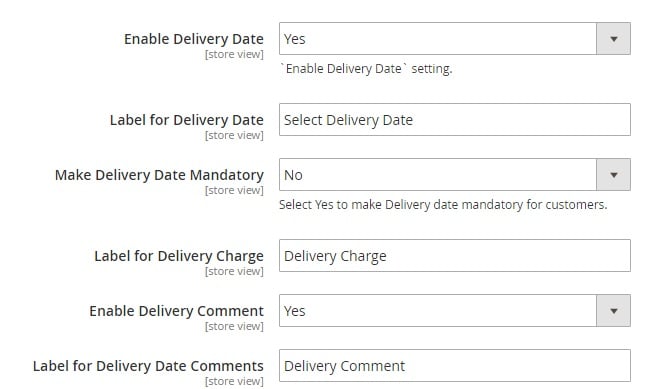
Besides, you can turn on the “Call me before delivery” option, which sometimes works better than a delivery comment section. Additional information and email notifications may be enabled here as well. The number of days to send the reminder of occurrence and email notification ID may be configured in the same section. Display new delivery options for selected customer groups only if necessary.
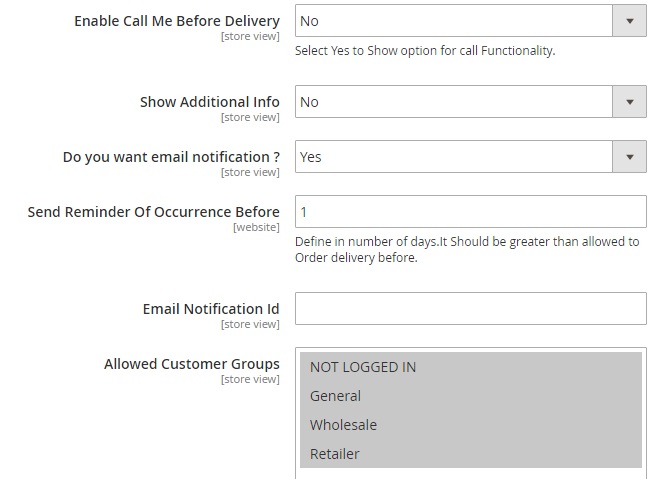
Create a delivery schedule layout. Choose either Calendar View or Time Slot View. To provide even more flexible options, enable time on the calendar. You can also specify minimum and maximum intervals of days between the order and delivery date. Same day and next day delivery options are represented in the same section as well.
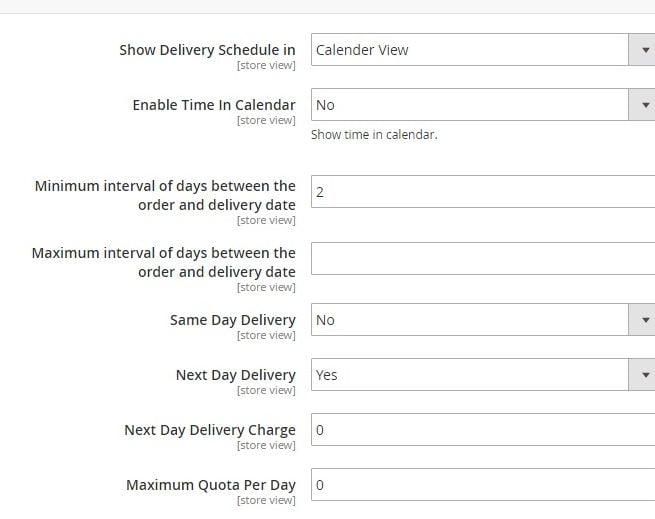
The Holiday Management section allows selecting Day Offs, specifying single day offs for particular dates of a year, and setting periods of vacation when the delivery options are disabled.
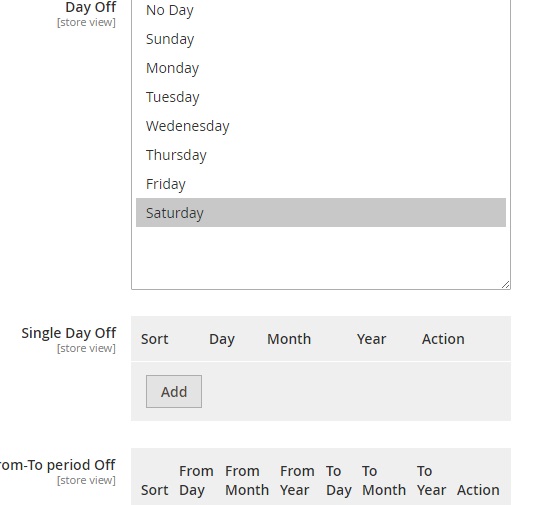
The Magento 2 delivery date extension by Magedelight changes the way the default order grid looks. The module adds a new column to inform your admins about the selected delivery conditions.

The same is about an order page, which also gets a new section:
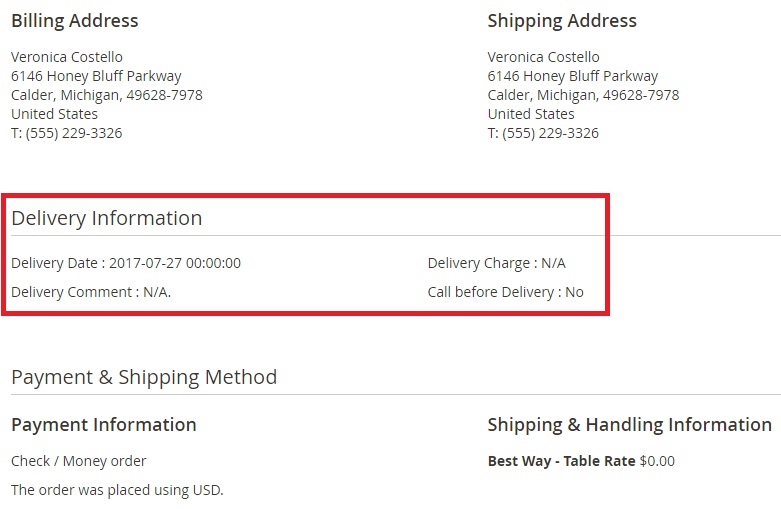
Frontend
Now, let’s say a few words about the frontend appearance of the MageDelight Delivery Date Magento 2 extension. As you might have already guessed, it adds a new section to the checkout page. Here is how it works:

The Magento 2 delivery date extension by Magedelight provides some competitive advantages over the Amasty Delivery Date extension, but, at the same time, it is more expensive. The module costs $179. For any further information, follow this link:









